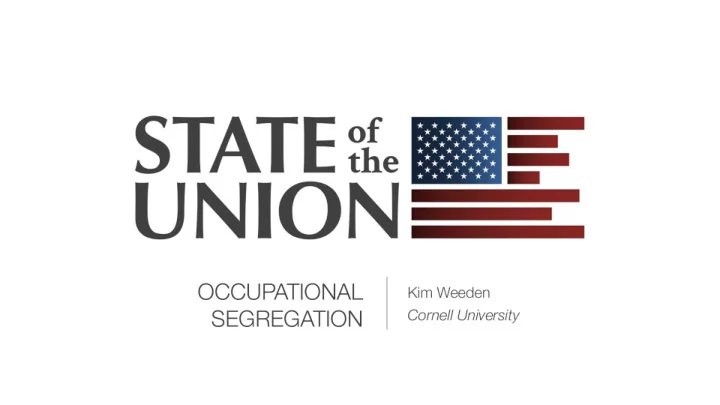

OCCUPATIONAL SEGREGATION KIM A. WEEDEN (Cornell University)
Millennials participate in labor force that is highly segregated by gender and race
Percentage of women workers by occupation group: millennials in 2015-2017 MA-level professions, technicians clerical classic professions (doctor, lawyer) sales service Women’s share of managers millennial production labor transportation and labor force construction trades, mechanics 0 10 20 30 40 50 60 70 80
Percentage of White or Black workers by occupation group: millennials in 2015-2017 Whites’ share of transportation and labor millennial clerical labor production force service Blacks’ sales share of MA-level professions, technicians millennial labor force managers classic professions (doctor, lawyer) construction trades, mechanics 0 10 20 30 40 50 60 70 80
How segregated are millennials? 47% 27% of millennials would need to of Black millennials would switch to a gender-atypical need to switch to a white- occupation to integrate the dominated occupation to labor market integrate the labor market 22% of Hispanic workers
Trends in segregation
Is gender segregation declining for millennials? Millennials in 2015-17 GenX in 2015-17 Boomer in 2015-17 Millennials age 21-36 GenX age 21-36 Boomer age 21-36 0% 10% 20% 30% 40% 50% 60% Index of Dissimilarity (percentage of workers who need to switch to gender-atypical occupation to achieve full integration)
Is racial segregation declining for millennials? Millennials in 2015-17 GenX in 2015-17 Hispanic-White Segregation Boomer in 2015-17 Black-White Segregation Millennials age 21-36 GenX age 21-36 Boomer age 21-36 0% 10% 20% 30% 40% Index of Dissimilarity (percentage of worker who need to switch occupations to achieve full integration)
If current rate of integration persists Gender integration in 11 “generations” à 125 birth-year cohorts Black-white integration: ?
Trends in segregation • Glacial • Asymmetric • Unstable
Segregation is consequential
25% of the gender gap in hourly wages among college-educated millennials 39% of the Black-White pay gap 39% of the Hispanic-White pay gap
Why is segregation so persistent? Socialization Cultural beliefs Discrimination Household labor Spatial Human capital (gender) segregation (race)
• Gender segregation high, but declining • Racial segregation lower, but stagnant • Cannot rely on generational change alone
Thank you! Kim Weeden kw74@cornell.edu
Recommend
More recommend